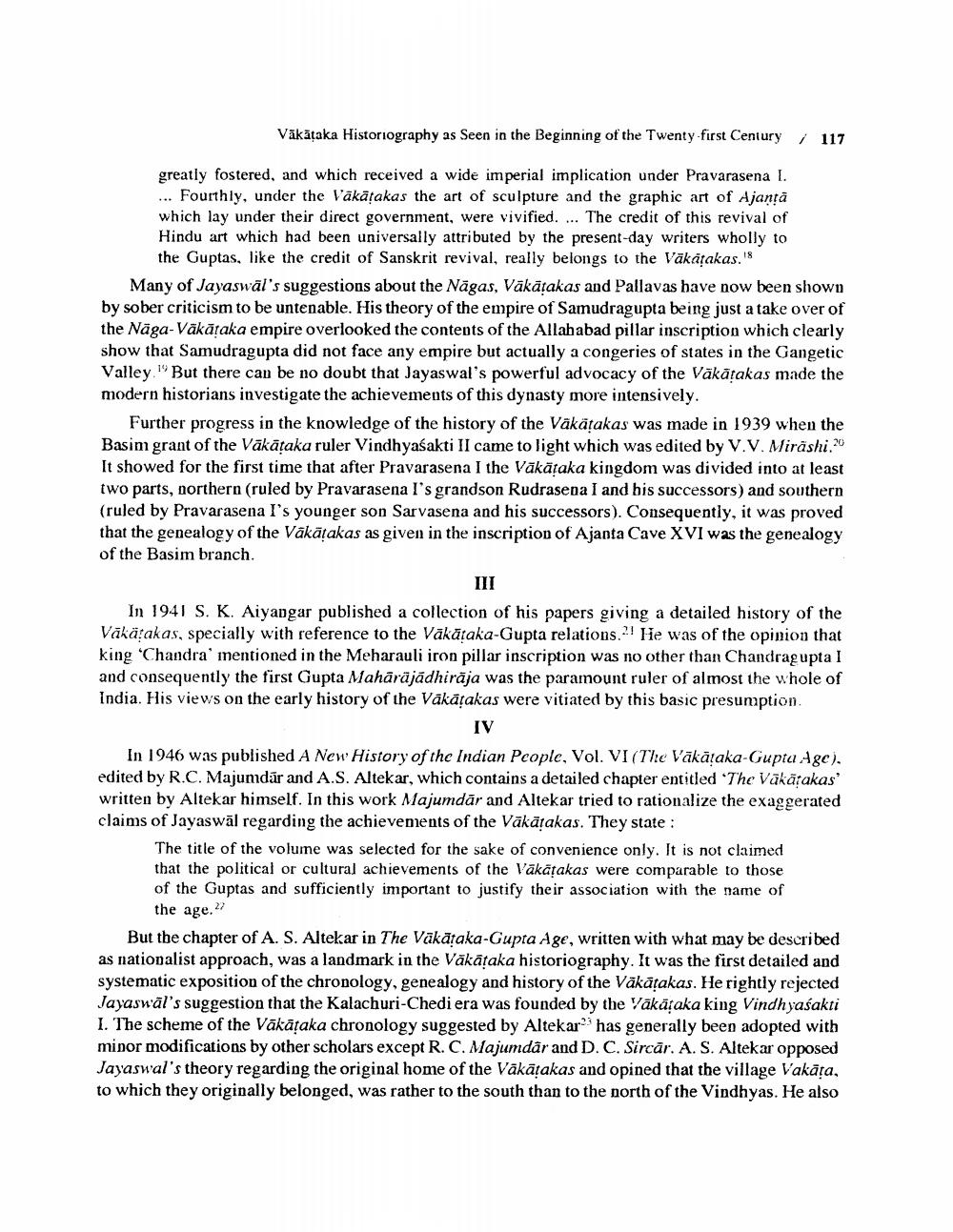________________
Väkätaka Historiography as Seen in the Beginning of the Twenty-first Century
/ 117
greatly fostered, and which received a wide imperial implication under Pravarasena I. ... Fourthly, under the Vākātakas the art of sculpture and the graphic art of Ajanta which lay under their direct government, were vivified. ... The credit of this revival of Hindu art which had been universally attributed by the present-day writers wholly to
the Guptas, like the credit of Sanskrit revival, really belongs to the Vākāțakas. Many of Jayaswal's suggestions about the Nāgas, Vākātakas and Pallavas have now been shown by sober criticism to be untenable. His theory of the empire of Samudragupta being just a take over of the Nāga-Vākātaka empire overlooked the contents of the Allahabad pillar inscription which clearly show that Samudragupta did not face any empire but actually a congeries of states in the Gangetic Valley. But there can be no doubt that Jayaswal's powerful advocacy of the Väkāļakas made the modern historians investigate the achievements of this dynasty more intensively.
Further progress in the knowledge of the history of the Vākäțakas was made in 1939 when the Basim grant of the Vākāțaka ruler Vindhyasakti II came to light which was edited by V.V. Miräshi.20 It showed for the first time that after Pravarasena I the Vākāțaka kingdom was divided into at least two parts, northern (ruled by Pravarasena l's grandson Rudrasena I and his successors) and southern (ruled by Pravarasena I's younger son Sarvasena and his successors). Consequently, it was proved that the genealogy of the Vākāļakas as given in the inscription of Ajanta Cave XVI was the genealogy of the Basim branch.
III In 1941 S. K. Aiyangar published a collection of his papers giving a detailed history of the Vākärakas, specially with reference to the Vākāraka-Gupta relations. He was of the opinion that king 'Chandra' mentioned in the Meharauli iron pillar inscription was no other than Chandragupta I and consequently the first Gupta Mahārājādhiraja was the paramount ruler of almost the whole of India. His views on the early history of the Vakārakas were vitiated by this basic presumption.
IV In 1946 was published A New History of the Indian People, Vol. VI (The Vākāļaka-Gupta Agc). edited by R.C. Majumdār and A.S. Altekar, which contains a detailed chapter entitled "The Vākātakas' written by Altekar himself. In this work Majumdār and Altekar tried to rationalize the exaggerated claims of Jayaswāl regarding the achievements of the Vākāļakas. They state :
The title of the volume was selected for the sake of convenience only. It is not claimed that the political or cultural achievements of the Väkäțakas were comparable to those of the Guptas and sufficiently important to justify their association with the name of
the age." But the chapter of A. S. Altekar in The Vākāšaka-Gupta Age, written with what may be described as nationalist approach, was a landmark in the Vākātaka historiography. It was the first detailed and systematic exposition of the chronology, genealogy and history of the Vākāțakas. He rightly rejected Jayaswäl's suggestion that the Kalachuri-Chedi era was founded by the Vākäraka king Vindhyasakti I. The scheme of the Vākāțaka chronology suggested by Altekar has generally been adopted with minor modifications by other scholars except R. C. Majumdär and D. C. Sircar. A. S. Altekar opposed Jayaswal's theory regarding the original home of the Vākātakas and opined that the village Vakāta, to which they originally belonged, was rather to the south than to the north of the Vindhyas. He also




